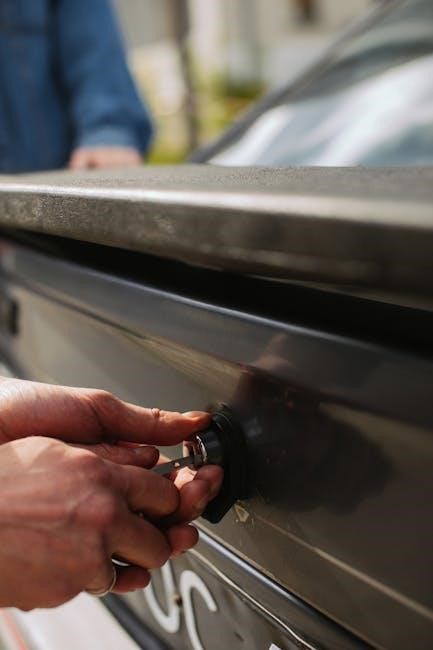Overhead door manuals are essential guides providing installation, maintenance, and troubleshooting instructions for various door types. They ensure safe and efficient operation, catering to residential, commercial, and industrial needs.
These manuals are crucial for users to understand door mechanisms, safety protocols, and repair procedures. By following the guidelines, users can maintain durability and functionality.
They also serve as a reference for professionals, ensuring compliance with safety standards and regulations. Overhead door manuals are indispensable for optimal performance and longevity of door systems.
1.1 What Are Overhead Door Manuals?
Overhead door manuals are comprehensive guides detailing installation, maintenance, and troubleshooting procedures for overhead doors. They provide essential information on door components, safety measures, and operational guidelines. These manuals are designed to assist homeowners, technicians, and professionals in ensuring proper functionality and longevity. By following the manual, users can address common issues and maintain optimal door performance effectively. They serve as a vital resource for safe and efficient operation.
1.2 Importance of Overhead Door Manuals
Overhead door manuals are crucial for ensuring safety, proper installation, and maintenance. They provide step-by-step guidance, reducing the risk of accidents and extending door lifespan. These manuals also help users troubleshoot common issues, saving time and money. Compliance with safety standards and regulations is emphasized, preventing potential legal issues. They are essential for both DIY enthusiasts and professionals, ensuring efficient and secure door operation.

Types of Overhead Door Manuals
Overhead door manuals are categorized into residential, commercial, and industrial types, each tailored to specific needs and applications. They provide detailed instructions for installation, maintenance, and repair, ensuring optimal functionality and safety. These manuals are designed to address the unique requirements of different door systems, offering comprehensive guidance for users.
2.1 Residential Overhead Door Manuals
Residential overhead door manuals are designed for homeowners, providing detailed instructions for installation, maintenance, and troubleshooting of garage doors and similar residential door systems. These manuals typically include safety guidelines, DIY repair tips, and manufacturer-specific recommendations to ensure proper functionality and longevity. They are essential for understanding door mechanisms, addressing common issues, and performing routine maintenance to prevent accidents and extend the door’s lifespan.
2.2 Commercial Overhead Door Manuals
Commercial overhead door manuals are tailored for businesses, offering detailed instructions for large-scale door systems commonly found in warehouses, factories, and retail spaces. These manuals emphasize durability, safety, and compliance with industry standards. They typically include manufacturer-specific guidelines for heavy-duty doors, such as rolling doors or sectional doors, ensuring proper installation, maintenance, and troubleshooting. These resources are essential for maintaining smooth operations and preventing costly downtime in high-traffic environments.
2.3 Industrial Overhead Door Manuals
Industrial overhead door manuals cater to heavy-duty applications in factories, warehouses, and large-scale facilities. These manuals provide detailed instructions for high-cycle doors designed to withstand harsh environments. They include specifications for loading capacities, safety protocols, and maintenance for doors made from robust materials. Additionally, they address unique challenges like extreme temperatures and high-traffic use, ensuring optimal performance and longevity in demanding industrial settings.

Key Components of Overhead Door Manuals
Overhead door manuals include installation guides, maintenance tips, troubleshooting steps, safety protocols, technical diagrams, compliance information, and manufacturer-specific details to ensure proper door functionality and user safety.
3.1 Installation Instructions
Installation instructions in overhead door manuals provide step-by-step guidance for proper door setup, including tool requirements, safety precautions, and alignment procedures. They detail how to mount brackets, secure springs, and attach hardware. Clear diagrams often accompany text to ensure accurate installation. These instructions emphasize pre-installation checks and post-installation testing to guarantee smooth operation and longevity of the door system.
3.2 Maintenance and Repair Guidelines
Maintenance and repair guidelines in overhead door manuals outline routines to ensure longevity and functionality. They cover lubrication of moving parts, inspection of springs and cables, and tightening of hardware. Repair sections provide diagnostic steps for common issues, such as misalignment or worn components, and offer solutions like part replacement or adjustment. Regular maintenance is emphasized to prevent major repairs and ensure safe operation.
3.4 Troubleshooting Common Issues
Overhead door manuals provide step-by-step guides to diagnose and resolve frequent problems. Issues like uneven door alignment, faulty sensors, or motor malfunctions are addressed with clear instructions. Users are advised to inspect components, test safety features, and reset systems when necessary. Advanced troubleshooting may require specialized tools or professional intervention to ensure safe and effective resolution of recurring issues.

Safety Guidelines in Overhead Door Manuals
Overhead door manuals emphasize proper handling, weight awareness, and safety device checks to prevent accidents. Users are warned about entrapment hazards and instructed to keep clear of moving parts. Regular inspections and adherence to safety protocols are stressed to ensure safe operation and minimize risks associated with door mechanisms and automation systems.
4.1 General Safety Precautions
Overhead door manuals highlight essential safety measures to prevent accidents. Always wear protective gear, ensure proper door installation, and keep the area clear of obstacles. Regularly inspect springs, cables, and rollers for wear. Never attempt repairs without disconnecting power. Keep children and pets away from operating doors. Follow manufacturer guidelines for weight limits and operational safety to avoid potential hazards and ensure smooth functionality.
4.2 Emergency Procedures
In case of an overhead door malfunction, disconnect power immediately and avoid operating the door. Contact a certified technician for assistance. Secure the area to prevent accidents. Never attempt manual lifting or repairs during an emergency. Follow the manual’s emergency stop procedures to ensure safety. Keep emergency contact information handy and prioritize caution to avoid further damage or injury.
4.3 Hazard Identification
Overhead door manuals highlight potential hazards such as crushing risks, entrapment, and falling components. Users are warned about pinch points, electrical dangers, and malfunctioning sensors. Proper identification of these risks ensures proactive safety measures, like installing safety sensors and regular inspections, to prevent accidents and injuries. Awareness of these hazards is critical for safe operation and maintenance of overhead doors.
DIY vs. Professional Installation
Overhead door manuals often compare DIY and professional installation, weighing factors like cost, time, and complexity. DIY can save money but requires technical skill, while professionals ensure safety and compliance, though at a higher cost. The choice depends on the user’s expertise and the door’s complexity.
5.1 Pros and Cons of DIY Installation
DIY installation of overhead doors offers cost savings and flexibility but requires technical skills and time. Pros include lower expenses and the ability to work at your own pace. However, cons involve safety risks, potential warranty voidance, and the complexity of handling heavy materials. Improper installation can lead to door malfunction or injury, making it crucial to weigh these factors carefully.
5.2 When to Hire a Professional
Hire a professional for overhead door installation if you lack experience with complex systems or heavy machinery. Experts ensure safety, proper alignment, and functionality. They handle large or specialized doors, high-tech features, and warranty requirements. Professionals also provide long-term reliability and peace of mind, especially for commercial or industrial setups where safety and efficiency are critical.

Manufacturer-Specific Overhead Door Manuals
Manufacturer-specific manuals provide detailed instructions tailored to particular brands and models, ensuring compatibility and optimal performance. They often include proprietary features, warranty information, and brand-specific safety guidelines.
6.1 Major Brands and Their Manuals
Prominent brands like Chamberlain, LiftMaster, and Amarr offer detailed manuals for their overhead doors. These guides include specific installation, maintenance, and troubleshooting instructions tailored to their products. They often feature diagrams, warranty details, and brand-specific safety tips. Adhering to these manuals ensures proper functionality, safety, and compliance with manufacturer warranties, making them indispensable for users of these trusted brands.
6.2 Differences in Manual Content
Manual content varies significantly between brands and door types. Residential manuals focus on safety, DIY installation, and basic maintenance, while commercial manuals emphasize regulatory compliance and advanced features. Industrial manuals often include technical specifications and heavy-duty maintenance procedures. Brands like LiftMaster and Chamberlain cater to residential needs, whereas Amarr and Clopay provide detailed industrial solutions, reflecting their target markets and product complexities.

Troubleshooting Common Overhead Door Issues
This section provides solutions for frequent overhead door problems, such as stuck doors or faulty sensors, helping users identify and resolve issues quickly and safely.
7.1 Door Not Opening or Closing
Troubleshooting a door that won’t open or close involves checking power sources, sensors, and track obstructions; Ensure the door is unplugged if manual operation is needed. Verify sensors are clean and aligned properly. Lubricate rollers and hinges if stuck. Check springs for tension and cables for damage. If issues persist, contact a professional to avoid further damage or safety risks.
7.2 Noise and Vibration Problems
Noise and vibration issues often arise from worn or loose components. Check for loose bolts, hinges, or rollers and tighten them. Lubricate moving parts like springs and rollers regularly. Misaligned tracks can cause vibrations; ensure proper alignment. Replace worn-out parts immediately. Excessive noise may indicate a need for professional adjustment or part replacement to maintain smooth operation and prevent further damage.
7.3 Sensor Malfunction
Sensor malfunctions can prevent proper door operation. Clean sensors regularly, as dirt or debris may block their function. Check alignment and ensure sensors are properly paired. Test sensors by passing objects through the beam. If issues persist, consult the manual or contact a professional for recalibration or replacement to restore safe and reliable door functionality.

Compliance and Regulations
Overhead door manuals ensure adherence to local building codes, safety standards, and environmental regulations. Compliance guarantees safe installation, operation, and minimizes legal and environmental risks effectively.
8.1 Local Building Codes
Overhead door manuals must align with local building codes, ensuring structural integrity and safety. These codes outline specific requirements for door materials, strength, and installation methods. Compliance guarantees public safety, prevents legal issues, and ensures doors meet regional standards for emergency exits, fire resistance, and accessibility. Proper adherence avoids penalties and ensures smooth inspections and approvals.
8.2 Safety Standards
Overhead door manuals emphasize adherence to recognized safety standards to minimize risks. These standards, set by organizations like OSHA and UL, outline requirements for door operation, sensor reliability, and emergency features. Compliance ensures user safety, reduces accidents, and meets legal obligations. Regular inspections and maintenance are crucial for upholding these standards and preventing potential hazards.
8.3 Environmental Regulations
Overhead door manuals often address environmental regulations to promote sustainability. These include energy efficiency standards, material recycling guidelines, and noise reduction requirements. Compliance with regulations like ENERGY STAR and ISO 14001 ensures eco-friendly practices. Manuals may also cover proper disposal methods for hazardous materials and encourage the use of environmentally responsible components. Adherence supports both legal and ecological responsibilities.

Choosing the Right Overhead Door Manual
Selecting the right manual involves understanding your door’s specifications, brand, and model. Ensure it covers installation, maintenance, and safety guidelines tailored to your needs for optimal functionality.
9.1 Factors to Consider
When selecting an overhead door manual, consider door type, brand compatibility, and user skill level. Ensure it includes safety standards, clear instructions, and diagrams. Check for language availability and digital access options. Verify if it covers maintenance, troubleshooting, and compliance with local regulations. Also, look for environmental considerations and energy efficiency guidelines tailored to your specific needs.
9.2 Matching Manual to Door Type
Ensure the manual aligns with your door’s specific type, whether residential, commercial, or industrial. Residential doors may require simpler instructions, while commercial or industrial doors need detailed technical specifications. Verify the manual addresses your door’s unique features, such as material, size, and mechanism. Proper alignment ensures accurate installation, maintenance, and troubleshooting, preventing potential errors and safety issues. Always cross-reference the manual with your door model for compatibility and clarity.
9.3 Brand-Specific Requirements
Overhead door manuals often include brand-specific requirements tailored to the manufacturer’s design and technology. These may involve proprietary hardware, software, or safety features unique to the brand. Users must adhere to these guidelines to ensure proper functionality and compliance with warranties. Always refer to the official manual for your specific brand to avoid mismatches or installation errors. This ensures optimal performance and safety standards are met. Proper alignment is crucial for long-term reliability and efficiency.

Advanced Features in Modern Overhead Door Manuals
Modern overhead door manuals now include smart integration, automation, and energy-saving features, enhancing functionality and user experience while improving safety and efficiency.
10.1 Smart Door Integration
Smart door integration allows overhead doors to connect with home automation systems, enabling remote monitoring and control via smartphones. This feature enhances security, convenience, and energy efficiency by allowing users to open, close, or monitor door status from anywhere. Advanced systems can also integrate with voice assistants like Alexa or Google Home for seamless voice commands. Notifications can be sent for unauthorized access or system malfunctions, ensuring added safety and peace of mind. Energy-efficient settings can be programmed to optimize usage automatically, reducing operational costs over time.
10.2 Automation and Control Systems
Automation and control systems in overhead doors offer advanced functionality, including programmable timers, remote controls, and sensor-activated operations. These systems enhance efficiency by automating door movements based on preset conditions. Programmable logic controllers (PLCs) enable precise control for industrial applications, while touchscreens and keypads provide intuitive operation. Automation reduces manual intervention, improving safety and reducing wear and tear on door components over time.
10.3 Energy Efficiency Features
Modern overhead door manuals emphasize energy efficiency, detailing features like insulation, thermal breaks, and weatherstripping to minimize heat loss. Automated systems with timers and sensors reduce unnecessary operation, lowering energy consumption. Smart technologies integrate with building management systems to optimize energy use. These features not only reduce energy bills but also contribute to environmental sustainability, aligning with global energy-saving initiatives and regulations.
Case Studies and Real-World Applications
Explore real-world examples showcasing overhead door installations across residential, commercial, and industrial sectors, highlighting practical applications and benefits of proper manual-guided door systems.
11.1 Residential Case Studies
Homeowners have successfully installed and maintained overhead doors using detailed manuals, ensuring smooth operation and safety. A family in suburban Chicago used a manual to install a garage door, while another in Texas followed guidelines to repair a noisy door. These residential case studies highlight how proper manual adherence improves functionality and extends door lifespan significantly.
11.2 Commercial Case Studies
Businesses have utilized overhead door manuals to enhance efficiency and safety in commercial settings. A warehouse in California implemented manual guidelines to install heavy-duty doors, improving workflow. Retail stores in New York followed maintenance tips to reduce downtime. These commercial case studies demonstrate how adherence to manuals ensures reliable operation, safety, and longevity of overhead doors in demanding environments.
11.3 Industrial Case Studies
Industrial facilities have benefited significantly from overhead door manuals, ensuring smooth operations in demanding environments. A manufacturing plant in Texas used manual guidelines to install and maintain large industrial doors, reducing downtime and enhancing safety. Similarly, a logistics center in Illinois followed manual instructions to optimize door functionality, improving workflow efficiency and adhering to strict industrial standards and regulations.

Customer Reviews and Testimonials
Customers often praise the clarity and detailed instructions in overhead door manuals, which help them troubleshoot and maintain their doors effectively. Some users appreciate the step-by-step guides, while others mention room for improvement in diagrams and technical explanations.
12.1 Positive Feedback
Many users commend overhead door manuals for their clear, concise instructions, making installation and maintenance manageable. Homeowners appreciate the troubleshooting sections, while businesses highlight the manuals’ role in ensuring smooth operations. The inclusion of detailed diagrams and safety tips is frequently praised, enhancing overall user satisfaction and confidence in handling door systems effectively.
12.2 Common Complaints
Some users report that overhead door manuals can be overly technical, making them difficult to understand. Others mention incomplete troubleshooting sections or lack of detailed diagrams. A few users find the instructions too generic, failing to address specific models or unique installation scenarios. These issues can lead to confusion and frustration, especially for DIY enthusiasts or those with limited technical expertise.
12.3 User Experiences
Users often highlight the clarity and helpfulness of overhead door manuals, especially when they include detailed diagrams and step-by-step instructions. Many appreciate the troubleshooting sections for resolving common issues quickly. However, some users note that manuals could be more user-friendly, with better organization and clearer language. Positive experiences often involve smooth installations and efficient problem-solving, while negative ones stem from unclear or incomplete guidance.
Overhead door manuals are essential for safe and efficient operation, providing critical guidance for installation, maintenance, and troubleshooting. They cater to various needs, from residential to industrial settings, ensuring compliance with safety standards. By following these manuals, users can maximize door longevity and functionality. As technology advances, modern manuals integrate smart features, enhancing user convenience. Always refer to your specific manual for optimal results.
